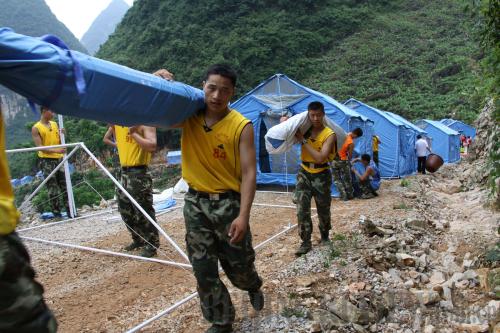|
 |
|
A HELPING HAND: Armed police in Guangxi Zhuang Autonomous Region help people of Yao ethnic group build up tents on June 19 for those who lost their homes (XINHUA) |
On the night of June 21 the Fuhe River, Jiangxi's second largest, burst its banks due to days of heavy rainfall. The local flood control office said the opening in the dike expanded to 400 meters the next day. More than 90,000 people affected by flood waters were evacuated. The floods are the worst for 50 years and over 25 million people have been affected, according to the local government.
Hui Liangyu, Chinese Vice Premier and Director of the State Flood Control and Drought Relief Headquarters (shortened as Flood Control Headquarters), ordered the evacuation of locals from the area and emergency measures began.
According to figures from the headquarters, heavy flooding in southern provinces had claimed 365 lives by June 24. An additional 147 are missing and 59.85 million people have been affected. The economic loss was approximately 70.9 billion yuan ($10.4 billion). The figures are on the rise.
Most casualties were due to landslides, mudflows and mountain flash floods caused the pounding rain. By midnight June 22, a total of 2.4 million people living alongside waterways were taken to safe areas while 763,000 houses were swept away or damaged by the flooding. The agricultural sector in the south was heavily impacted, as 3.76 million hectares of farmland were destroyed by storms.
Quick response
The southern part of China is densely populated with the most robust economic growth. Officials said 70 percent of damage caused by the floods in China was in the south.
At 10 p.m. on June 21, Flood Control Headquarters raised the flood emergency response to level two from three, and dispatched seven expert groups to the south to oversee flood control.
To relieve flooding in Jiangxi, the headquarters sent 1,630 rescue boats to the province along with 1,700 portable risk-detection lights and 5,000 life jackets. The air force also sent five helicopters.
Flood Control Headquarters said the Central Government had appropriated 1.29 billion yuan ($189 million) by June 22 to the provinces that had been hit by the flooding.
In spite of the enormous toll, experts believed the damage caused by the floods is less than that of drought or extreme cold, said Li Guoxiang, an agricultural expert at the Chinese Academy of Social Sciences. In 1998, when the south suffered from the biggest flood in history, the record high for grain output was reached.
Bizarre weather
In an interview with the People's Daily, Zhang Zhitong, Deputy Director of Flood Control Headquarters, said there would be six to eight typhoons hitting the mainland this year and warned they may cause even more damage.
| 